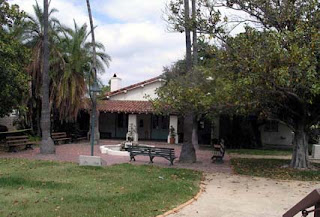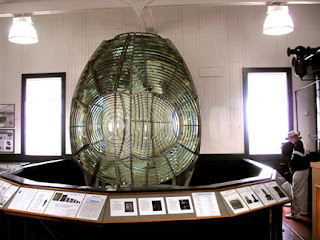Los Angeles County -
July 28, 1997 & June 14, 2009
North on 101 for 3.3 miles to
Lankershim Blvd. and next to Universal City Station (metro).
Ah, memories of earlier days in the music business at the mention of Lankershim Blvd; the Palomino Club, Nudie’s Rodeo Tailors, The Sportsman’s Lodge…but we’re here in the shadows of Universal City to the site where 110 years prior to Nudie Cohn stitching up Elvis’ gold lame suit, the Mexican Army capitulated and made an agreement with American forces to stop shooting at each other while a treaty was put together.
1976 photo
To describe the details of that agreement it’s best to leave it to Warrant Officer 1 Mark J. Denger representing the California State Military Museum and their fine website on California’s military history.
“At the site of an abandoned adobe ranch-house, Lieutenant Colonel John C. Frémont signed a treaty, generally termed the "Capitulation of Cahuenga," with General Andres Pico of
Mexico. This was a significant treaty that led indirectly to
California's statehood by ending rival hostilities in
California for the duration of the Mexican War.
Campo de Cahuenga was once a part of Rancho Verdugo, occupied by Mariano de la Luz Verdugo. In 1810 the San Fernando Mission had taken over Rancho Partezuela, the Verdugo ranch, and had dammed up the
Los Angeles River running behind the Campo de Cahuenga site so as to raise corn and squash for the mission. At that time, the mission fathers built a building for the housing of workers and seed storage. In 1845 Tomas Feliz, the new occupant of the land, doubled the size of this building which is now known as the Tomas Feliz Adobe.
In January of 1847, the last two serious military engagements against
U.S. forces invading
California were fought at the battles of
San Gabriel and
La Mesa just below
Los Angeles. Gen. Flores, seeing the situation as hopeless, now moved north of the city. In the meantime, Frémont arrived in the
Los Angeles area from the north
It was on January 11, 1847, a few miles above
San Fernando, that Col. Frémont received a message from Gen. Kearny informing him of the defeat of the enemy and the capture of
Los Angeles. That night Frémont's battalion encamped in the mission buildings at
San Fernando. From the mission Col. Frémont sent Jesus Pico to find the
California army and open negotiations with its leaders. Jesus Pico, a cousin of Gen. Andres Pico, found the advance guard of the Californians encamped on the Verdugo Ranch.
Detained there, Pico informed the leading officers of the army of Frémont's arrival and the number of his men. With the combined forces of Frémont and Stockton, now in
Los Angeles, he urged them to surrender to Frémont as they could obtain better terms from him than from
Stockton.
General Flores, who had been appointed by the territorial assembly governor and comandante-general, had taken his departure for
Mexico on January 11. Before departing he appointed Gen. Andres Pico commanding-general and gave him command of the army.
General Pico, on assuming command, appointed Francisco Rico and Francisco de La Guerra to confer with Col. Frémont.
Meanwhile, Frémont appointed Major P. B. Reading, Major William H. Russell and Captain Louis McLane as commissioners to negotiate a treaty. Gen. Pico, in turn, appointed Jose A. Carrillo, commander of the cavalry squadron, and Augustin Olvera, disputaso of the assembly, and moved his army near the
Los Angeles river at Cahuenga. On the 13th Frémont moved his camp to the Cahuenga.
The commissioners met in the deserted ranch-house of Tomas Feliz (Campo de Cahuenga), and a treaty was drawn up.
The principal conditions of the treaty of "Capitulation of Cahuenga," as it was termed, were that the Californians, on delivering up their artillery and public arms, and promising not to again take up arms during the war, and conforming to the laws and regulations of the
United States, shall be allowed to peaceably return to their homes. They were to be allowed the same rights and privileges as are allowed to citizens of the United States, and were not to be compelled to take an oath of allegiance until a treaty of peace was signed between the United States and Mexico, and were given the privilege of leaving the country if they so wished to do so.
The terms being mutually acceptable to both Colonel Frémont and General Andres Pico, it was signed. An additional section was added to the treaty on the 16th at
Los Angeles releasing the officers from their paroles.
In accordance with the terms of the treaty, two cannon were surrendered, the howitzer captured from Gen. Kerny at San Pasqual, and the "Old Woman's Gun" that won the battle of Dominguez Ranch.
On January 14, Frémont marched his battalion through the
Cahuenga Pass to
Los Angeles and entered it four days after its surrender to
Stockton. The conquest of
California was now complete. Frémont presented the treaty to Stockton, who approved it.
In a little more than six months, U.S. naval forces of the Pacific Squadron, aided by the California Battalion, two companies of dragoons, and the Morman Battalion, had seized and pacified the whole area that is, today, the state of California.
To Frémont's credit, the treaty of Campo de Cahuenga (shown below) brought peace with honor, allowing both nationalities in
California to calmly assimilate into the
United States. The treaty was consolidated into the final treaty of Guadalupe Hidalgo of February 2, 1848, between the
United States and
Mexico.”
According to their webpage, the site is currently closed for renovations, as it was in 2009, but will be open soon.
Plaque inscription: NO. 151
CAMPO DE CAHUENGA - 'Here was made the Treaty of Cahuenga by General Andrés Pico, commanding forces for
Mexico, and Lieutenant-Colonel J. C. Frémont, U.S. Army, for the
United States. By this treaty, agreed upon January 13th, 1847, the
United States acquired
California - finally secured to us by the treaty of Guadalupe Hidalgo, made February 2nd, 1848.' This legend was written February 9, 1898 by Mrs. Jessie Benton Frémont. Location:
3919 Lankershim Blvd, North Hollywood
GPS 34.139759,-118.361973











































